東大塾長の山田です。
このページでは、「三角関数のグラフの書き方」について解説します。
三角関数のグラフは、形を丸暗記するのではなく、「なぜこのようなグラフになるのか」を理解することが重要です。
今回は「基本の三角関数のグラフ書き方」から、「複雑な三角関数のグラフの書き方とそのコツ」まで、順を追って丁寧にわかりやすく解説していくので、ぜひ勉強の参考にしてください!
1. 三角関数のグラフの書き方
まずは基本となる「\( y = \sin \theta \)」「\( y = \cos \theta \)」「\( y = \tan \theta \)」のグラフの書き方からやっていきましょう。
1.1 \( y = \sin \theta \) のグラフ
\( y = \sin \theta \) の値は、次の表のようになります。

したがって、\( \color{red}{ y = \sin \theta } \) のグラフは次のようになります。
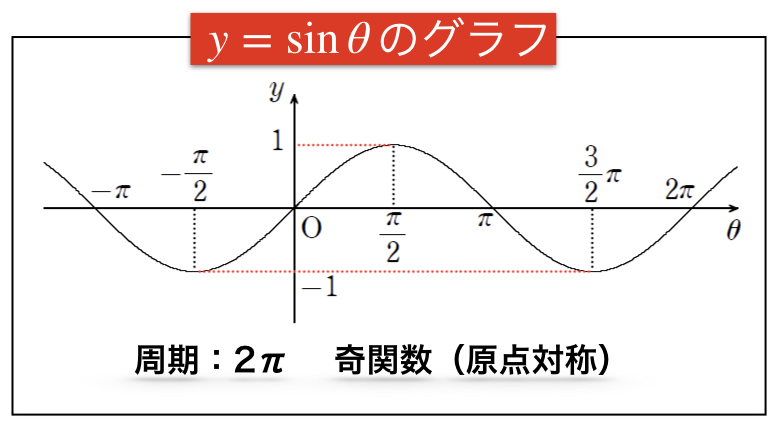
- 周期は \( 2 \pi \)
- \( \theta \) は実数全体,\( -1≦y≦1 \)
- 原点に関して対称(奇関数)
1.2 \( y = \cos \theta \) のグラフ
\( y = \cos \theta \) の値は次の表のようになります。

したがって、\( \color{red}{ y = \cos \theta } \) のグラフは次のようになります。
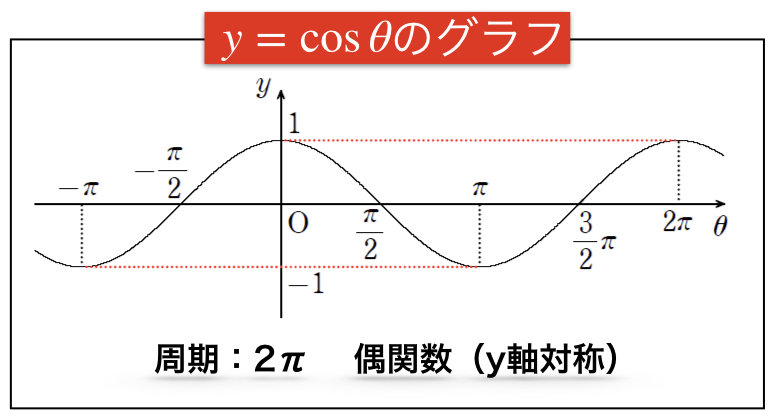
- 周期は \( 2 \pi \)
- \( \theta \) は実数全体,\( -1≦y≦1 \)
- \( y \) 軸に関して対称(偶関数)
また、\( y = \sin \theta \),\( y = \cos \theta \) のグラフを正弦曲線といいます。
1.3 \( y = \tan \theta \) のグラフ
次は \( y = \tan \theta \) のグラフです。
\( \tan \theta \) は、単位円で考えたときの傾きとなります。
したがって、\( \displaystyle \theta = \frac{\pi}{4} \) のとき \( y=1 \) になり、\( \displaystyle \theta = \frac{\pi}{2} \) に近づくにつれ、\( y \) は \( \infty \) に近づいていきます。
\( \displaystyle \theta = \frac{\pi}{2} \) を超えると \( y = – \infty \) になり、\( \displaystyle \theta = \pi \) のときは \( y = 0 \) 、そして \( \displaystyle \theta = \frac{3}{2} \pi \) に向かうとまた \( y = \infty \) になります。
\( \theta \) が負の方向も考えると、\( y = \tan \theta \) のグラフは次のようになります。
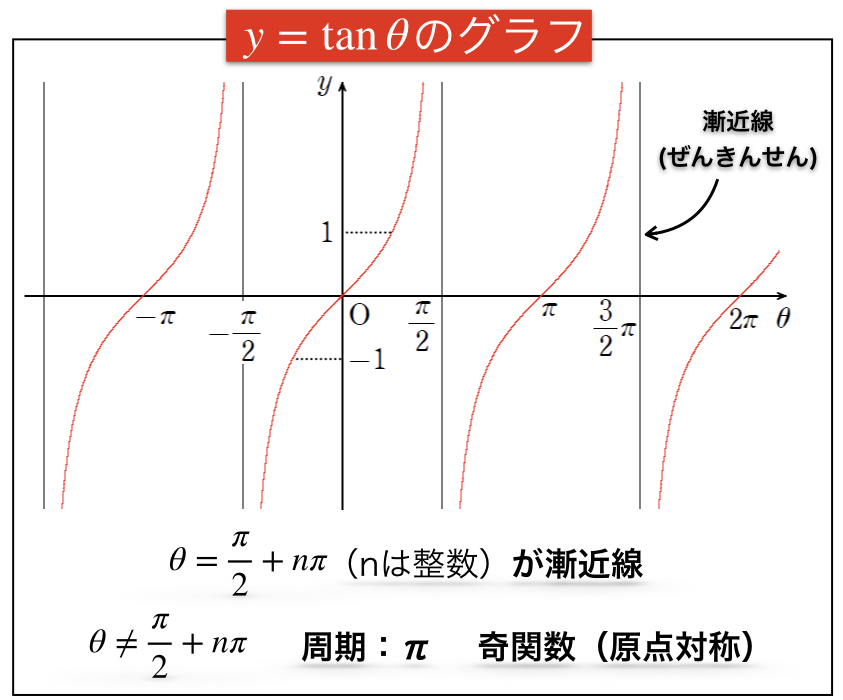
\( \tan \theta \) は、\( \displaystyle \theta = – \frac{\pi}{2}, \frac{\pi}{2}, \frac{3}{2} \pi \) は定義されないので、\( \displaystyle \color{red}{ \theta \neq \frac{\pi}{2} + n \pi } \) となります。
また、\( \displaystyle \theta = \frac{\pi}{2} \) ように、曲線が一定の直線に限りなく近づく直線を、曲線の 漸近線(ぜんきんせん)といいます。
\( y = \sin \theta \),\( y = \cos \theta \) のグラフは似ていますが、\( y = \tan \theta \) のグラフはまったく違う形になるので注意が必要です。
- 周期は \( \pi \)
- \( y \) は任意の実数値をとる
- 原点に関して対称(奇関数)
- 直線 \( \displaystyle \theta = \frac{\pi}{2} + n \pi \)(\( n \)は整数)が漸近線
2. 周期関数
三角関数のグラフについて、もう少し説明を加えていきます。
\( y = \sin \theta \),\( y = \cos \theta \) のグラフは、\( 2 \pi \) ごとに同じ形が繰り返されます。
(公式 \( \sin ( \theta + 2 \pi ) = \sin \theta \),\( \cos ( \theta + 2 \pi ) = \cos \theta \) からも確認できます。)
また、\( y = \tan \theta \) のグラフは、\( \pi \) ごとに同じ形が繰り返されます。
(公式 \( \tan ( \theta + \pi ) = \tan \theta \) からも確認できます。)
このように、関数 \( y = f(x) \) について、0でない定数 \( p \) があり、すべての \( x \) について
\( f(x+p) = f(x) \)
が成り立つとき、\( f(x) \) を、\( p \) を周期とする 周期関数 といいます。
したがって、三角関数は周期関数となります。
・\( \sin \theta \)の周期:\( \color{red}{ 2 \pi } \)
・\( \cos \theta \)の周期:\( \color{red}{ 2 \pi } \)
・\( \tan \theta \) の周期:\( \color{red}{ \pi } \)
3. 偶関数・奇関数
すべての \( x \) について \( f(-x) = -f(x) \) が成り立つとき、\( f(x) \) を奇関数といいます。
一方、\( f(-x) = f(x) \) が成り立つとき、\( f(x) \) を偶関数といいます。
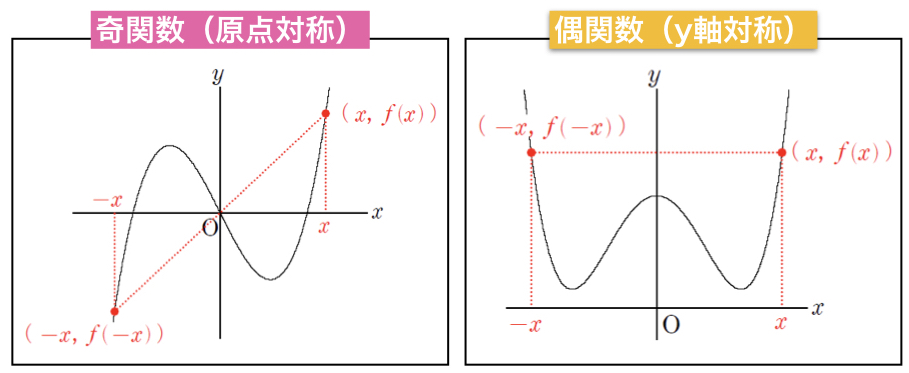
偶関数のグラフは\( y \) 軸に関して対称であり、奇関数のグラフは原点に関して対称です。
したがって、三角関数はそれぞれ次のようになります。
・\( \sin (- \theta) = – \sin \theta \):奇関数(原点対称)
・\( \cos (- \theta) = \cos \theta \):偶関数(\( y \) 軸対称)
・\( \tan (- \theta) = – \tan \theta \):奇関数(原点対称)
4. 複雑な三角関数のグラフの書き方
ここまでは、三角関数の基本となる形のグラフの解説でした。
次は、試験で出題される複雑な三角関数のグラフについて解説していきます。
4.1 \( y = a \sin \theta \) のグラフ
まずは「\( y = \color{red}{ a } \sin \theta \)」の形のグラフです。
\( y = \color{red}{ a } \sin \theta \) のグラフは、基本の\( y = \sin \theta \) のグラフを \( y \) 軸方向に \( a \) 倍に拡大(縮小)したものです。
周期は基本の \( y = \sin \theta \) と同じで \( 2 \pi \) です。
【例1】
- \( y = \color{red}{ 2 } \sin \theta \) は \( y = \sin \theta \) のグラフを \( y \) 軸方向に \( 2 \) 倍に拡大したもの
- \( \displaystyle y = \color{red}{ \frac{1}{2} } \sin \theta \) は \( y = \sin \theta \) のグラフを \( y \) 軸方向に \( \displaystyle \frac{1}{2} \) 倍に縮小したもの
となるので、グラフはそれぞれ次のようになります。
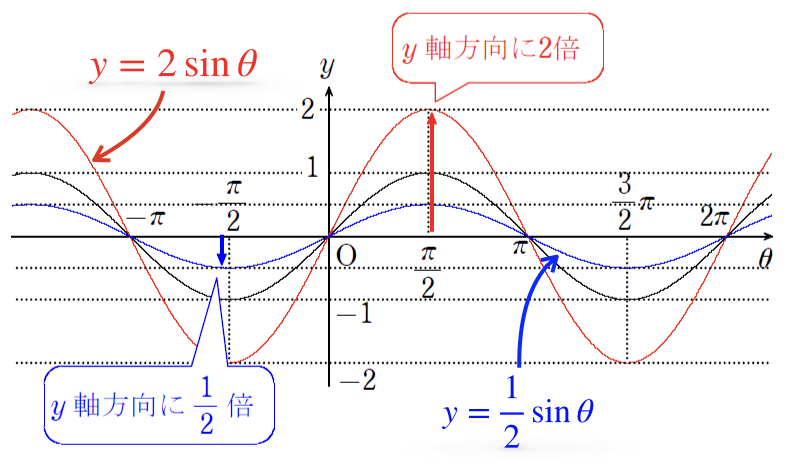
4.2 \( y = \sin (\theta – p) \) のグラフ
次は「\( y = \sin (\theta \color{red}{– p }) \)」の形のグラフです。
\( y = \sin (\theta \color{red}{– p }) \) のグラフは、基本の\( y = \sin \theta \) のグラフを \( \theta \) 軸方向に \( p \) だけ平行移動したものです。
これは数学Ⅰの「2次関数の平行移動」の考え方と同じです。
周期は基本の \( y = \sin \theta \) と同じで \( 2 \pi \) です。
【例1】
\( \displaystyle y = \sin \left( \theta \color{red}{ – \frac{\pi}{3} } \right) \) は \( y = \sin \theta \) のグラフを \( \theta \) 軸方向に \( \displaystyle \frac{\pi}{3} \) だけ平行移動したものなので、グラフは次のようになります。
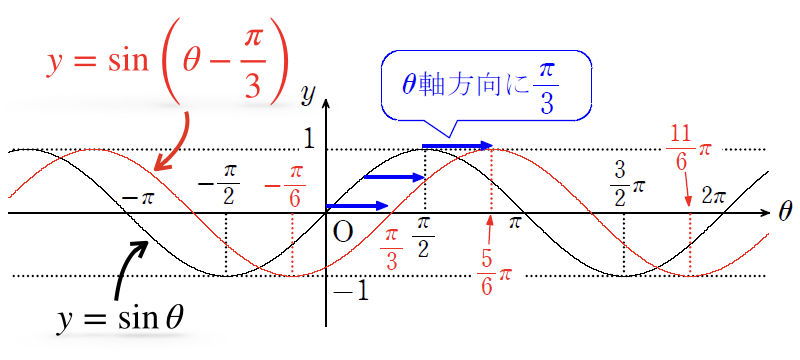
【例2】
\( \displaystyle y = \cos \left( \theta \color{red}{ + \frac{\pi}{4} } \right) \) は \( y = \cos \theta \) のグラフを \( \theta \) 軸方向に \( \displaystyle – \frac{\pi}{4} \) だけ平行移動したものなので、グラフは次のようになります。
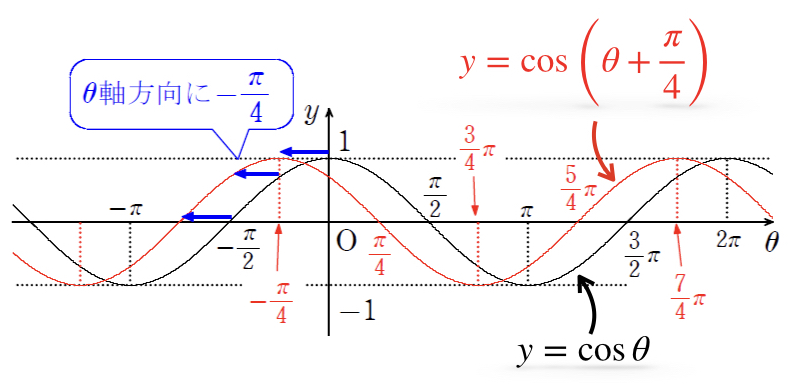
4.3 \( y = \sin (k \theta) \) のグラフ
さいごは「\( y = \sin (\color{red}{ k } \theta) \)」の形のグラフです。
\( y = \sin (\color{red}{ k } \theta) \) のグラフは、基本の\( y = \sin \theta \) のグラフを \( \theta \) 軸方向に \( \displaystyle \frac{1}{k} \) 倍に拡大(縮小)したものです。
\( y = \sin \color{red}{ 2 } \theta \) のグラフを例に考えてみましょう。
【例1】 \( y = \sin 2 \theta \)

上の表のとおり、\( y = \sin \color{red}{ 2 } \theta \) のグラフは、基本の\( y = \sin \theta \) のグラフを \( \theta \) 軸方向に \( \displaystyle \color{red}{ \frac{1}{2} } \) 倍に縮小したものであることが確認できます。
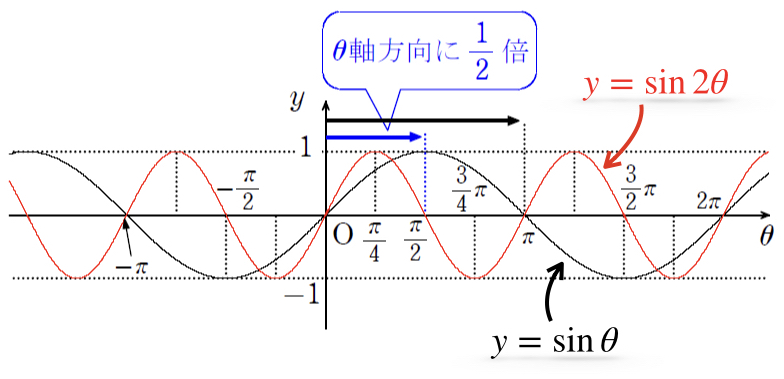
また、\( y = \sin \color{red}{ 2 } \theta \) のグラフの周期は、\( y = \sin \theta \) の周期の \( \displaystyle \color{red}{ \frac{1}{2} } \) となるので、周期は \( \displaystyle 2 \pi \times \frac{1}{2} = \color{red}{ \pi } \) となります。
【例2】
\( \displaystyle y = \sin \color{red}{ \frac{\theta}{2} } \) のグラフは、基本の\( y = \sin \theta \) のグラフを \( \theta \) 軸方向に \( 2 \) 倍に拡大したもので、周期は \( 2 \pi \times 2 = \color{red}{ 4 \pi } \) となります。
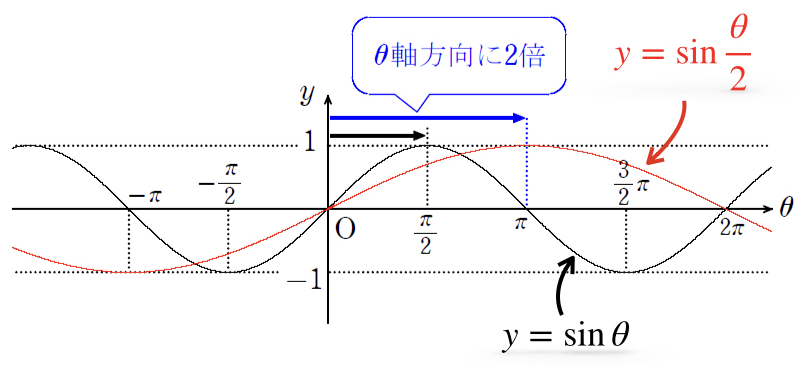
これで基礎・基本は完了です。
ここまでの内容を一度まとめておきます。
- 「\( y = a \sin \theta \)」\( \cdots \)\( y = \sin \theta \) のグラフを \( y \) 軸方向に \( a \) 倍に拡大(縮小)したもの。周期は \( 2 \pi \)。
- 「\( y = \sin (\theta – p) \)」\( \cdots \)\( y = \sin \theta \) のグラフを \( \theta \) 軸方向に \( p \) だけ平行移動したもの。周期は \( 2 \pi \)。
- 「\( y = \sin (k \theta) \)」\( \cdots \)\( y = \sin \theta \) のグラフを \( \theta \) 軸方向に \( \displaystyle \frac{1}{k} \) 倍に拡大(縮小)したもの。周期は \( \displaystyle 2 \pi \times \frac{1}{k} \)。
5. 複雑な三角関数のグラフの問題
それでは実戦問題に入りましょう。
関数 \( \displaystyle y = 2 \sin \left( \frac{1}{2} \theta + \frac{\pi}{3} \right) \) のグラフをかけ。また、その周期を求めよ。
基本のグラフ \( y = \sin \theta \) との関係(拡大・縮小,平行移動)を調べていき、どのようなグラフになるかを求めていきます。
【解答】
\( \displaystyle y = 2 \sin \left( \frac{1}{2} \theta + \frac{\pi}{3} \right) = \color{red}{ 2 \sin \frac{1}{2} \left( \theta + \frac{2}{3} \pi \right) } \)
よって、\( \displaystyle y = 2 \sin \left( \frac{1}{2} \theta + \frac{\pi}{3} \right) \) のグラフは、基本形 \( y = \sin \theta \cdots ① \) をもとにして、次のようになる。
[1] ① を \( y \) 軸方向に \( 2 \) 倍に拡大
⇒ \( y = 2 \sin \theta \cdots ② \)
[2] ② を \( \theta \) 軸方向に \( 2 \) 倍に拡大(\( \displaystyle \frac{1}{2} \) 倍ではないので注意!!)
⇒ \( \displaystyle y = 2 \sin \frac{1}{2} \theta \cdots ③ \)
[3] ③ を \( \theta \) 軸方向に \( \displaystyle – \frac{2}{3} \pi \) だけ平行移動
⇒ \( \displaystyle y = 2 \sin \frac{1}{2} \left( \theta + \frac{2}{3} \pi \right) \cdots ④ \)
したがって、グラフは下の図の赤実線部分。
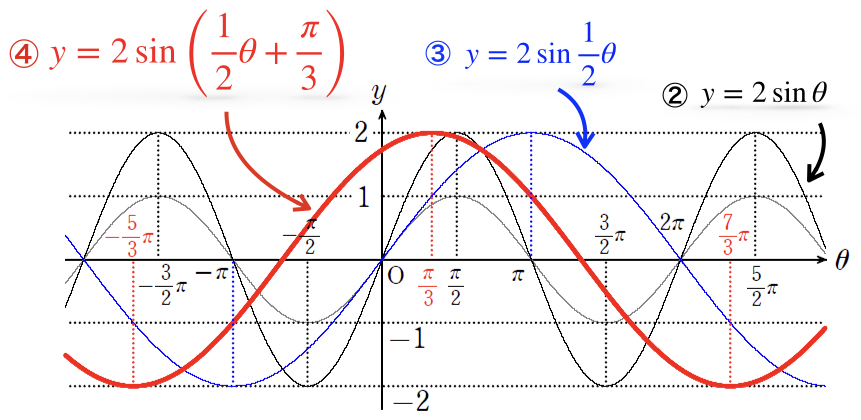
周期は \( \displaystyle 2 \pi \times 2 = \color{red}{ 4 \pi \cdots 【答】 } \)
\( \displaystyle y = 2 \sin \left( \frac{1}{2} \theta + \frac{\pi}{3} \right) \) のグラフが、「\( \displaystyle 2 \sin \frac{1}{2} \theta \) のグラフを \( \theta \) 軸方向に \( \displaystyle – \frac{\pi}{3} \) だけ平行移動したもの」と考えるのは誤りなので、注意しましょう!!
実際に試験で答案をかくときには、解答の図のように①,②,③を書く必要はありません。
周期が \( 4 \pi \) であることを求め、あとは曲線上の主な点(\( \theta \) 軸との交点や最大・最小となる点)をとって、なめらかな線で結んでかけばよいです。
6. 三角関数のグラフまとめ
さいごに今回の内容をもう一度整理します。
- \( y = \sin \theta \) のグラフ\( \cdots \)奇関数(原点対称)で、周期は \( 2 \pi \)。
- \( y = \cos \theta \) のグラフ\( \cdots \)偶関数(\( y \) 軸対称)で、周期は \( 2 \pi \)。
- \( y = \tan \theta \) のグラフ\( \cdots \)奇関数(原点対称)で、周期は \( \pi \)。直線 \( \displaystyle \theta = \frac{\pi}{2} + n \pi \)(\( n \)は整数)を漸近線とする。
- 「\( y = a \sin \theta \)」\( \cdots \)\( y = \sin \theta \) のグラフを \( y \) 軸方向に \( a \) 倍に拡大(縮小)したもの。周期は \( 2 \pi \)。
- 「\( y = \sin (\theta – p) \)」\( \cdots \)\( y = \sin \theta \) のグラフを \( \theta \) 軸方向に \( p \) だけ平行移動したもの。周期は \( 2 \pi \)。
- 「\( y = \sin (k \theta) \)」\( \cdots \)\( y = \sin \theta \) のグラフを \( \theta \) 軸方向に \( \displaystyle \frac{1}{k} \) 倍に拡大(縮小)したもの。周期は \( \displaystyle 2 \pi \times \frac{1}{k} \)。
- 複雑な三角関数のグラフの書き方\( \cdots \)基本のグラフ \( y = \sin \theta \) との関係(拡大・縮小,平行移動)を調べてかく。
以上が三角関数のグラフの書き方の解説です。今回の内容をおさえておけば、三角関数のどんなグラフでもかけるはずです。
三角関数のグラフをかけるようにして、三角関数をマスターしてください!


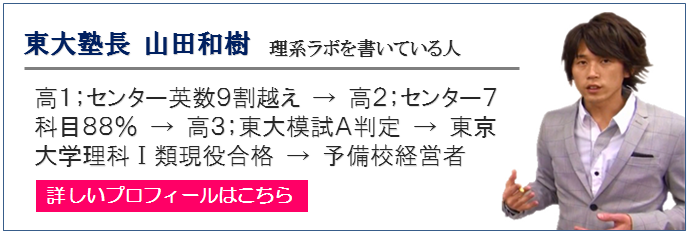
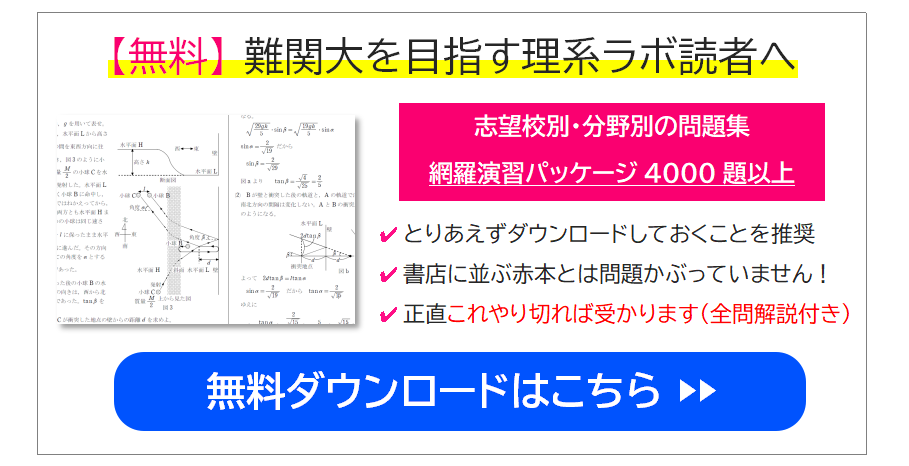











すごい!
欲を言うとtanθのグラフも書いてほしかったです
tanθのグラフが一番わかりにくいと思うのでその解説が欲しかったです
共通テストではあまりtanθのグラフは出ないからではないでしょうか?
それな
sin cosわかったけどtanは理解しにくかったのを解消してくれた!
ありがとうございます!
cos(-kθ)の場合が分からない。グラフをそのままX軸を軸に反対に書けばいいのか…
単位円で想像すると分かりますが、θ(反時計回り)でも−θ(時計回り)でもcos(x座標)は変わりません!
したがって、cos(-kθ)=cos(kθ)です!
(y=cosθのグラフがy軸に対して対称なことからも、θの正負は関係なく絶対値によってcosが決定することがわかります)
y=acosθのグラフを書く時は基本となるy=cosθのグラフも書かなければいけないんですか?
cos やtanのグラフも同じようにして求められるんですか?
y=2sin(1/2θ+π/3)=2sin1/2(θ+2/3π)
π/3がなぜ2/3πになるのでしょうか?
(1/2θ+π/3)=1/2(θ+2/3π)と変形しています。
(右辺を計算すると左辺に戻ると思います)
横幅がxのグラフ教えてくれ
y=asinθのaが負の場合はどうなりますか?
y=sinθをa倍するのは aが正でも負でも変わりません
仮にy=-asinθ を求めるとすると、y=sinθ を-a倍することになります
ただし、-a倍というのは1/a倍と等しいです
>-a倍というのは1/a倍と等しいです
ここの意味が分かりません。
マイナスというのはグラフで言うなら上下の向きが逆転するのであって、割るという意味にはならないはずです
>y=asinθのaが負の場合はどうなりますか?
この回答は
X軸を挟んで上下さかさまの形になり、さらに波の高さ(振幅)がa倍になる
が正しいのではないですか?
a=-Iとかだった場合グラフが上下反対になります。
このよいに負の場合でもやることは変わりません。
グラフひとつひとつを小さな点の集まりとみたら、それぞれの点の位置がマイナス方向絶対値a倍されたと、負の時は考えるといいと思います
5.複雑な三角関数のグラフのところに、赤で注意が書いてありますが、なぜこれはあやまりになるのでしょうか…!?
y=−cos(θ/2+π/3)のグラフの書き方を教えてください。
元高校教師です。数学教師ですが理科の免許もあり物理も教えていました、物理の受験生向けの授業は理科の先生ではちょっと無理なこともあって、そこは僕が教えていました。数Ⅱの三角関数の中心課題は「回転と周期性」です。そこがしっかり押さえられていないと物理では使い物になりません。したがってグラフの説明が拡大と平行移動で終わってはいけないと思います。「三角関数y=Asin(kx+l)+Bのグラフで波を表すことができます。だからあらためて波の観点からお話ししましょう。・・・・Aの大きさは波の振幅をその符号、Bは波の中心、kは波数といって、長さ2πあたりの波の個数、周期(あるいは波長)は2π/k、kx+l=0となるxから始まってkx+l=2πとなるxで終わる波を1個描いたらあとはその前後に連続させてゆけばグラフは描けます。」そうやって教えています。これは物理の授業でも生かされて、多くの受験生が苦手とする「波動関数」で躓く生徒は出てきませんでした。